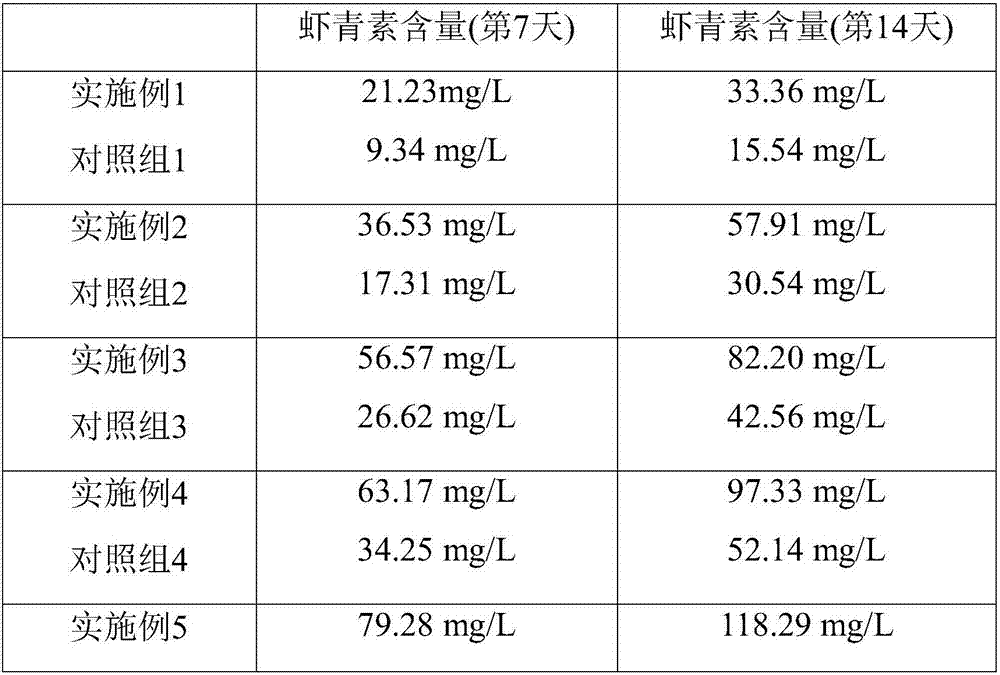A method of inducing Haematococcus pluvialls to produce astaxanthin
A technology of Haematococcus pluvialis and astaxanthin, which is applied in the field of microorganism application, can solve problems such as the inability to meet high-efficiency utilization, and achieve the effects of increasing yield, shortening time, and simple and easy method.
- Summary
- Abstract
- Description
- Claims
- Application Information
AI Technical Summary
Problems solved by technology
Method used
Image
Examples
Embodiment 1
[0029] Step 1. Massive propagation of algae species: inoculate Haematococcus pluvialis into the nutrient medium at a temperature of 22°C and a continuous light intensity of 20 μmol·m -2 ·s -1 And at the same time, continue to pass into the nutrient medium through filtering under the air condition of 1% carbon dioxide with a volume concentration, and its feed rate is to pass into 0.2L / min in every 1L of the nutrient medium, until Reach the end of the logarithmic growth phase of Haematococcus pluvialis, and obtain a large number of algae species;
[0030] Step 2. Production of astaxanthin: Inoculate Haematococcus pluvialls into the production medium, and produce astaxanthin at a temperature of 22°C, wherein the light on Haematococcus pluvialls is continuously maintained during the cultivation process, and Ensure that the light intensity reaching the cell surface of Haematococcus pluvialis is 20 μmol m -2 ·s -1 Adding ethanol to the nutrient medium at the same time, wherein th...
Embodiment 2
[0033] Step 1. Massive propagation of algae species: inoculate Haematococcus pluvialis into the nutrient medium at a temperature of 24°C and a continuous light intensity of 60 μmol·m -2 ·s -1 And at the same time, continue to pass into the nutrient medium through filtering under the air condition of 1% carbon dioxide with a volume concentration, and its feed rate is to pass into 0.2L / min in every 1L of the nutrient medium, until Reach the end of the logarithmic growth phase of Haematococcus pluvialis, and obtain a large number of algae species;
[0034] Step 2, producing astaxanthin: Inoculate Haematococcus pluvialls into the production medium, and produce astaxanthin at a temperature of 24°C, wherein the light on Haematococcus pluvialls is continuously maintained during the cultivation process, and Ensure that the light intensity reaching the cell surface of Haematococcus pluvialis is 60 μmol m -2 ·s -1 Adding ethanol and sea crystals simultaneously in the production mediu...
Embodiment 3
[0037] Step 1, mass reproduction of algae species: Inoculate Haematococcus pluvialis into the nutrient medium at a temperature of 26°C and a continuous light intensity of 100 μmol·m -2 ·s -1And at the same time, continue to pass into the nutrient medium through filtering under the air condition of 2% carbon dioxide with a volume concentration of 2%, and its feed rate is to pass into 0.3L / min in every 1L of the nutrient medium, until Reach the end of the logarithmic growth phase of Haematococcus pluvialis, and obtain a large number of algae species;
[0038] Step 2. Production of astaxanthin: inoculate Haematococcus pluvialls into the production medium, and produce astaxanthin at a temperature of 26°C, wherein the light on Haematococcus pluvialls is continuously maintained during the cultivation process, and Ensure that the light intensity reaching the cell surface of Haematococcus pluvialis is 100 μmol m -2 ·s -1 Add ethanol and sea crystal simultaneously in the production ...
PUM
| Property | Measurement | Unit |
|---|---|---|
| strength | aaaaa | aaaaa |
Abstract
Description
Claims
Application Information
 Login to View More
Login to View More - R&D
- Intellectual Property
- Life Sciences
- Materials
- Tech Scout
- Unparalleled Data Quality
- Higher Quality Content
- 60% Fewer Hallucinations
Browse by: Latest US Patents, China's latest patents, Technical Efficacy Thesaurus, Application Domain, Technology Topic, Popular Technical Reports.
© 2025 PatSnap. All rights reserved.Legal|Privacy policy|Modern Slavery Act Transparency Statement|Sitemap|About US| Contact US: help@patsnap.com


